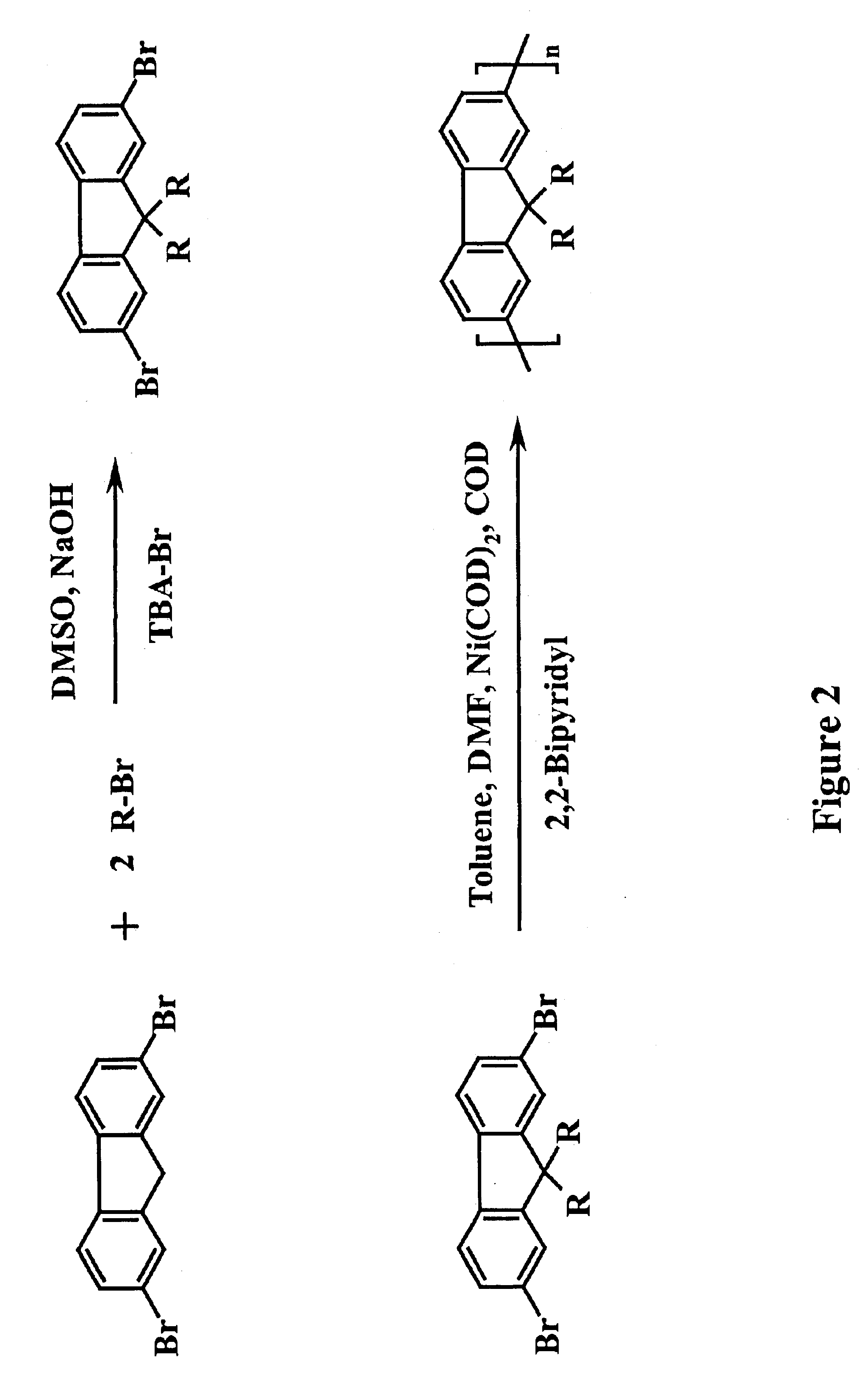Methods to purify polymers
a technology of polymer and purification method, which is applied in the direction of dyeing process, textiles and paper, etc., can solve the problems of increasing the recombination rate, the difficulty of purifying these polymers, and the limited commercial products developed so far. achieve the effect of effective removal of metallic impurities and high solubility
- Summary
- Abstract
- Description
- Claims
- Application Information
AI Technical Summary
Benefits of technology
Problems solved by technology
Method used
Image
Examples
example 1
Removal of Trace Metals from Polyfluorenes (PF)
[0034]Alkylsubstituted polyfluorenes have emerged as a very attractive class of semiconducting polymers, especially for display applications, owing to inherent pure blue and efficient electroluminescence emission coupled with a high charge-carrier mobility and good processability [U. Scherf and E. J. W. List, Advanced Materials, 2002, 14(7), 477]. Transition metal-catalyzed ary-aryl-coupling has paved the way for the synthesis of high molecular weight, structurally well-defined PF derivatives. FIG. 2 shows a general synthetic route to poly(9,9-diakylfluorene-2,7-diyl)s for Yamamoto-type reductive polycondensation of dihaloaryl compounds with Ni(COD)2 as an effective aryl-aryl coupling agent [T. Yamamoto; Synlett, 2003, No.4, 425]. Here it is noted that DMSO stands for dimethyl sulfoxide, TBA-Br is tetrabutylammonium bromide, DMF is N,N-Dimethylformamide, COD is bis(1,5-cyclooctadiene)nickel(0), and R is any alkyl group. For illustration...
example 2
Removal of Trace Metals from Polythiophenes
[0041]Owing to their good solubility, processability, environmental stability, electroactivity, polythiophenes, poly(3-alkythiopnenes) in particular, are another class of conjugated polymers which exhibit a variety of potential applications including rechargeable battery electrodes, electrochromic devices, chemical and optical sensors, light-emitting diodes, microelectrochemical amplifiers and field effect transistors. Three chemical synthetic methods for polythiophenes have been developed. These are oxidative polymerization of 3-alkylthiophene by ferric chloride (FeCl3), catalyzed dehalogenation of 2,5-dihalo-3-alkylthiophene by nickel (Ni), and regiocontrolled synthesis mediated by Rieke Zinc (Zn) as shown schematically in FIG. 3. Here, THF is tetrahrofuran, RT is room temperature, R is any alkyl group, and Ni(DPPE)Cl2 is 1,2-bis(diphenylphosphion) ethane]nickel(II) chloride. All these polymerization methods involved transition metals. In...
example 3
Polymer Light Emitting Diode (PLED)
[0045]To determine the effect of removal of impurities from polymers according to this invention, light emitting diodes were fabricated using the polyfluorenes before purification and after purification as demonstrated in example 1 and the characteristics are compared. A standard device configuration, ITO / PEDOT / Polymer / Ba / Al, was adopted. Device fabrication and testing were carried out in a dry-box with a controlled N2 atmosphere at room temperature. The fabrication procedure is given below.
[0046]A 130-nm-thick layer of poly(enthylendioxythiophene):poly (styrene sulfonic acid) (PEDOT:PSS, Bayer Batron 4083) was spin-cast (at 2000 rpm) onto pre-cleaned ITO-glass substrates. Next, a light emitting polymer (PFO-P0 or PFO-PC) was spin-cast at room temperature under ambient conditions from a toluene / THF solution to form a thin film about 80 nm. The solvent was thoroughly removed by subsequently baking the samples on a hot plate. The Ba cathode (50 nm th...
PUM
| Property | Measurement | Unit |
|---|---|---|
| mass ratio | aaaaa | aaaaa |
| mixing time | aaaaa | aaaaa |
| temperature | aaaaa | aaaaa |
Abstract
Description
Claims
Application Information
 Login to View More
Login to View More - R&D
- Intellectual Property
- Life Sciences
- Materials
- Tech Scout
- Unparalleled Data Quality
- Higher Quality Content
- 60% Fewer Hallucinations
Browse by: Latest US Patents, China's latest patents, Technical Efficacy Thesaurus, Application Domain, Technology Topic, Popular Technical Reports.
© 2025 PatSnap. All rights reserved.Legal|Privacy policy|Modern Slavery Act Transparency Statement|Sitemap|About US| Contact US: help@patsnap.com



